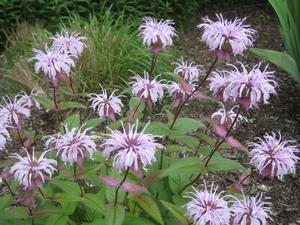Printed at http://www.newmoonnursery.com/index.cfm/
Monarda bradburiana
Eastern beebalm
Native to North America
FIRST IMPRESSIONS: Monarda bradburiana is a compact clumping perennial wildflower. Plants have gray-green aromatic leaves on strong square stems. In late spring, stems are topped by showy rounded clusters of pale pink tubular flowers speckled with purple. Pollinators flock to the blooms in sunny or partly shaded gardens with average well drained soils.
HABITAT & HARDINESS: Monarda bradburiana occurs in the central and southern United States from Indiana to Alabama and west to Kansas, Arkansas and Texas. The greatest distribution is in Illinois, Missouri and Arkansas.
This species is indigenous to savannas, rocky upland forests, thickets, limestone or sandstone glades, woodland meadows, bluffs, roadsides and abandoned fields.
Plants are hardy from USDA Zones 5-8.
PLANT DESCRIPTION: Monarda bradburiana is an upright bushy perennial with square green stems.
The aromatic leaves are opposite and sessile or almost so. The blades are gray-green and lanceolate to ovate. They are over 3” long and about 2” wide with toothed edges and pointed tips.
The stems terminate in dome shaped 2-3” flower clusters. The flowers are tubular, fragrant and about 1” long. Each corolla tube is actually a ring of united petals with soft pinkish-lavender color and purple spots. The tubes are pubescent with lobes toward the tip and exserted stamens.
The flowers are born in a ring on each dense head-like cyme. The lobes and stamens of individual flowers give the flower clusters a ragged appearance.
Blooming lasts for about 3-4 weeks and is followed by ovoid nutlets that are nestled into the head-like cyme.
Plants grow 1-2’ tall with an equal spread.
CULTURAL & MAINTENANCE NEEDS: Monarda bradburiana thrives in sun or part shade with well drained soil. Plants tolerate drought and shallow rocky infertile soils.
Plants bloom more vigorously if they are divided in spring or fall every 3-4 years.
This species is resistant to powdery mildew. Irrigation during drought and pruning to thin dense growth helps to enhance the resistance.
The aromatic foliage is unpalatable to deer, rabbits and other herbivores.
LANDSCAPE USES: This is a good choice for a Wildlife Garden, Cut Flower Garden, or Meadow. Plants are also used as Butterfly Nectar Plants or as part of a Grouping or Mass Planting. Monarda bradburiana has Showy Blooms and is appropriate for Cottage Gardens, Deer Resistant Plantings, Water-wise Landscapes, Low Maintenance Plantings and Perennial Borders.
COMPANION & UNDERSTUDY PLANTS: In sunny sites try pairing Monarda bradburiana with Coreopsis tripteris, Rudbeckia hirta, Liatris spicata and Sporobolus heterolepis.
Monarda fistulosa has similar appearance and culture and could be substituted in some situations.
TRIVIA: Long tongued bees, butterflies, skippers, hummingbird moths and hummingbirds sip nectar from the flowers. Caterpillars of several moth species feed on the foliage. The aromatic leaves and stems are unpalatable to deer and other herbivores.
Monarda bradburiana is touted by many as a superior beebalm for the garden. Attributes include its mildew resistance, short stocky stature, earlier bloom time and less aggressive spreading than other Monarda spp.
Renowned garden designer Piet Oudolf used Monarda bradburiana in his plans for New York City’s Highline and Chicago’s Lurie Garden.
The species was formerly known as Monarda rigida and Monarda villosa.
Height:
1-2 ftSpread:
1-2 ftSpacing:
18 inUSDA Hardiness Zone:
5-8Bloom Color:
Pink, WhiteMonarda bradburiana Characteristics
Attracts Wildlife
- Butterflies
- Pollinators
- Hummingbirds
Attributes
- Drought Tolerant
- Dried Flower
- Cut Flower
- Rock Garden
- Clay Soil
- Naturalizing
- Fragrant
- East-Coast Native
Exposure
- Full Sun to Partial Shade
Deer Resistant
- Deer Resistant
Flowering Months
- May
Foliage Color
- Gray-Green
Groundcover Foot-Traffic Tolerances
- Light
Growth Rate
- Medium
Juglans nigra Tolerance (Black Walnut)
- Yes
Season of Interest (Foliage)
- Spring
Soil Moisture Preference
- Dry to Moist

